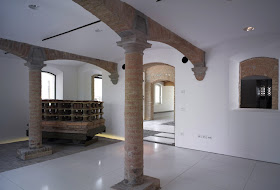CASALGRANDE OLD HOUSE BY KENGO KUMA & ASSOCIATES
B
CASALGRANDE
OLD HOUSE BY KENGO KUMA & ASSOCIATES
A rural
Italian villa converted into a showroom for ceramics company Casalgrande Padana design
by Kengo Kuma & Associates. The refurbished brick building provides an
event space and a series of galleries for product displays.
Large white
tiles placed onto pebble-covered floors mark pathways through the building,
while some other tiles provide the treads for a staircase that leads to the two
upper floors.
More tiles
hang from the ceiling as decoration, plus some mounted onto bookshelves
function as louvered lighting screens.
KENGO KUMA’S
EXPLANATION ABOUT PROJECT
Casalgrande,
Reggio Emilia, Italy
We converted
a private brick house in Reggio nell'Emilia’s grassland to a gallery run by
Casalgrande Padana, a tile manufacturer. In its adjacent rotary, we had
designed a monument called “Ceramic Cloud” using large-sized tiles.
The design
theme for both the Old House and Ceramic House is lightness, thinness and
strength of the tile. In 20th century, tile was used as a finishing material
for concrete, a kind of cosmetics in architecture.
However, with
the development of technology in recent years, they now produce denser,
stronger, and larger tiles. Our objective was to create a light, “particled”
interior space using those larger tiles.
The tiles are
used mainly for treads of the stairs, bookshelves, tables and reflective plates
to disseminate light. In each purpose, we pursued delicate details to emphasize
the thinness and lightness of the tile.
Adding
“lightness” of the tile onto the “weightiness” of the old brick house would be
an interesting way to conserve historical architecture. This came from my notion
that nature itself could be gradational, and I began to think how we could make
things gradational.
If people’s
activities also can be described gradational, so would be their houses, in
various parameters.
http://www.dezeen.com/2012/02/24/casalgrande-old-house-by-kengo-kuma-and-associates/
A
A
A
A
KENGO KUMA
BIOGRAPHY
2008
Established Kuma & Associates Europe ( Paris, France)
1990
Established Kengo Kuma & Associates
1987
Established Spatial Design Studio
1979
Completed the Master Course, Department of Architecture, Graduate School of
Engineering, The University of Tokyo
1954
Born in Yokohama, Kanagawa Prefecture, Japan
TEACHING
& PROFESSORSHIPS
2009 -
Present - Professor at the Graduate School of Architecture, The University
of Tokyo
2007 – 2008 -
Visiting Professor at the School of Architecture, University of Illinois at
Urbana - Champaign ( Chicago, USA )
2001 – 2009 -
Proffessor at the Faculty of Science and Technology, Keio University
1998 – 1999 -
Proffessor at the Faculty of Environmental Information, Keio University
1994 -
Lecturer at the Graduate School of Architecture, Planning and
Preservation, Columbia University ( New York – USA )
1985 - 1986 -
Visiting Scholar Graduate School, Columbia University and Asian Cultural
Council ( USA )
PROFESSIONAL
AFFILIATION
First class
Architect in Japan
Architecte
DESA ( Diplome de l’ Ecole Speciale d’ Architecture
Architecte
Inscrit au Tableau de l’ Ordre des Architectes
International
Fellow for Royal Instıtute of British Architectes ( RIBA )
Honorary
Fellow fort he American Institude of Architects ( AIA )
Received a Ph
D from Keio University
AWARDS ( For
Kengo Kuma )
2012
The 6th ASIAGRAPH Award
Japan
Information – Cultuology Society Award
2011
The Minister of Education, Culture, Sports, Science and Technology’ s Art
Encouragement Prize for ‘’ Yusuhara Wooden Bridge Museum ‘’
2010
Mainichi Art Award for ‘’ Nezu Museum ‘’
2009
Decoration Officier de L ‘ Ordre des Arts et des Lettres ( France )
2008
Energy Performance + Architecture Award ( France )
Bois
Magazine International Wood Architecture Award ( France )
2002
Spirit of Nature Wood Architecture Award ( Finland )
2001
Togo Murano Award for ‘’ Nakagawa – machi Bato Hiroshige Museum ‘’
1997
Architectural Institute of Japan Award for ‘’ Noh Stage in the Forest ‘’
First
Place , AIA Dupont Benedictus award for ‘’ Water Glass ‘’ ( USA )



































